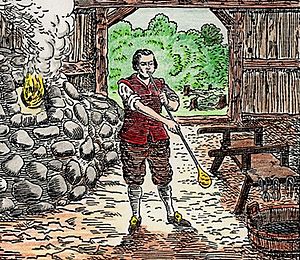Jamestown Polish craftsmen facts for kids
The Polish craftsmen in the Jamestown Colony were skilled workers. They arrived in 1608 with Captain John Smith. They came to help build important industries in the new American colony. Many people see them as the first Polish and Slovak Americans in the New World.
Early Days in Jamestown
The first Polish immigrants reached the Jamestown colony in 1608. This was 12 years before the Pilgrims landed in Massachusetts. These early settlers were brought by Captain John Smith. He was an English soldier and adventurer.
The Polish craftsmen were very skilled. They included a glass blower, a maker of pitch and tar, and a soap maker. There was also a timber worker. An English writer named Richard Hakluyt wrote in 1586 that colonies would need skilled people. He suggested finding them in places like Poland. These workers could make things like soap ashes, pitch, and tar.
Captain John Smith traveled to Poland in 1603 to find these skilled workers. Six Polish men traveled with him. For a long time, their names were not fully known. Then, in 1943, a historian named Karol Wachtl found their names. He looked through old Polish writings from the 1800s.
Later, in 1947, a story spread about a historical diary. It was called "Pamiętnik handlowca" ("A Merchant's Memoir"). People said it was written by Zbigniew Stefanski, a Pole who lived in Jamestown. This memoir supposedly said that Polish settlers taught the pioneers how to dig wells. It also said they fought for their right to vote. It even claimed they introduced settlers to baseball. However, no one has ever found the original diary.
Still, some famous names of these settlers are known today. They include Michał Łowicki, Zbigniew Stefański, Jan Mata, and Stanisław Sadowski. Captain John Smith also wrote in his journals that two craftsmen helped save his life. This happened during an Indian attack near the glasshouse.
In 1948–1949, people dug up the area where the glasshouse was. They found tools for making glass and many pieces of "common green glass." They found parts of window panes, bottles, and drinking jugs. The Glass House and the glass-making industry were started and run only by the Polish workers.
The Jamestown Strike
In 1619, the Polish settlers started a labor strike. This was against the Virginia Company, which ran the colony. They were successful in getting what they wanted. The skills of these Polish colonists were very important for the new settlement. The House of Burgesses was the first elected assembly in America. When they met in 1619, they did not allow the Polish community to vote.
Because of this, the Poles started a strike. This was the first recorded strike in the New World. The Virginia Company later wrote:
- "For pitch and tar, we advise and require that the Polackers be returned in part to these their works, with such other assistance as shall be necessary."
This means they wanted the Polish workers to go back to making pitch and tar. They also wanted them to have help. The company knew how important the Poles' skills were.
Why the Strike Mattered
The House of Burgesses needed the Polish workers and their skills. So, they gave the Poles the "rights of Englishmen." This meant they could vote. Historians say this struggle was important for many reasons. It was the first American labor strike. It was also a fight for civil rights and the right to vote. It was also the start of the first trade apprenticeship in the American colonies. An apprenticeship is when someone learns a skill from a master worker.
After this, the Poles also set up the first bilingual schools in the New World. They taught both Polish and English. Later, they added Latin and German to the lessons. However, the power of the Polish community became less strong. This happened because of more fighting with Native Americans.
How They Were Shown
One of the most famous pictures of the Jamestown Polish craftsmen is a painting. It is called Poles in Jamestown by Arthur Szyk. This painting was shown at the New York World Exposition in 1939. It was part of the Polish section.
The painting shows 11 Poles. But historical records say there were "eight Dutchmen and Poles." Historian Arthur Waldo asked Szyk why he painted 11. Szyk said he was inspired by historians from Poland. They wanted the painting to show a summer scene. Szyk chose to paint the second group of Polish craftsmen. They arrived in 1609. The first group was thought to have five Poles.
The painting also shows the Poles in tight pants and bright decorations. These clothes were typical of mountain regions. But their black summer hats were from Krakow. Szyk told Waldo that he showed them as peasants, not artisans. This allowed him more creative freedom to make folk costumes. It also helped create a clear Polish look. Szyk was happy that his painting showed Polish identity and pride.



